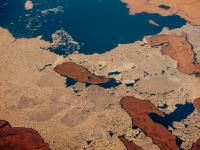Subscribe to the Newsletter
Your cart is empty
Shop now



















Arctic
“Horror Boréale” by Anne-Françoise Hivert for Le Monde M Magazine, October 2023. Translated from the original French.
For ten years, American photographer Mustafah Abdulaziz has been documenting the upheavals caused by global warming. Particularly at the North Pole, where the impact of human activity is more visible than anywhere else. Between declining glaciers and industrial settings, his series “Arctic” makes tangible the spectacle of a world on the path to self-destruction.
In the past, miners took a canary in a cage when they went underground. If the bird stopped singing, the men knew they had to get back to the surface as quickly as possible. Toxic gas circulated in the mine. The Arctic is now this canary, alerting humanity to the state of the planet. Nowhere else are temperatures rising as fast.
Over the past forty years, warming has been four times faster than in the rest of the world. This is just the beginning. In the coming decades, the phenomenon is expected to accelerate. The cause is the mechanism of Arctic amplification: in a warming global climate, the ice pack and snow are losing ground and thus reflect less of the sun's rays, the heat of which is then absorbed by the sea. All scientific studies are clear: by the 2030s, the Arctic could be deprived of ice packs in summer. On July 13, a record temperature of 28.8 °C was measured in Slettnes Fyr, at the northern tip of Norway. There is no shortage of images attesting to the upheavals in the region. They show skinny polar bears wading in the water, broken glaciers, indigenous peoples with disrupted lifestyles and tourists from all over the world coming on cruise ships to see the ice floes before they disappear.
It is towards this Far North that the American photographer Mustafah Abdulaziz, based in Berlin, has turned his lens. For ten years, he has documented the impact of climate change on human beings. He has worked extensively on the theme of water, an increasingly scarce resource in Asia, Africa and the United States. The Arctic is a new stage in his hunt for a world on the path to self-destruction. In 2022, he travelled to Greenland, the Norwegian archipelago of Svalbard, Alaska, northern Canada and Kiruna, the largest city in Swedish Lapland. He returned with photographs whose aesthetic recalls the world of fantasy. That of fairy tales – a mixture of black and white and colours. As if to recall what was and is no longer or perhaps never was, except in our imagination which continues to fantasize about wild spaces far from any civilization. In his photos, there are no polar bears, northern lights or snow-capped mountains. But the ice floe, reddened with the blood of a seal killed by a Greenlandic hunter. In Ilulissat, Greenland, Mustafah Abdulaziz photographs the port, clogged with trawlers, the docks, covered with crates of fish – overfished black halibut – that will be transported to the other side of the world. In Alaska, he flies over the Red Dog open-pit mine, which exploits the largest zinc reserve in the world. It also pollutes more than any other industrial installation in North America. He shows the greenish water of the lake in the heart of the mountain dug by man. In Kiruna, 200 kilometres north of the Arctic Circle, where the ground threatens to collapse, eaten away by the iron mine in which the Swedish group LKAB has just discovered an immense deposit of rare earths, he goes to meet the inhabitants in the process of moving the entire town. Mustafah Abdulaziz photographs skiers in an industrial setting, a cemetery in a Greenlandic village, and the fog caused by a heat wave in the Svalbard archipelago.
"I treat the Arctic as a dream while showing the idea that we have of it is based on prejudices and full of blind spots. However, this collective dream will turn into a nightmare, if we do not take seriously what is happening and if we continue to consider nature as a limitless fiction. It is time to react."
Mustafah Abdulaziz is part of »Guest Room: Boaz Levin & Sophia Greiff«.
Check out his Artist Feature Water.